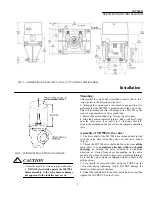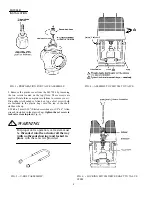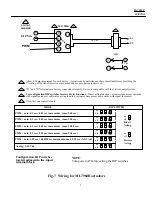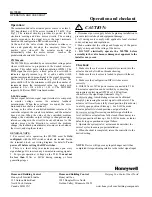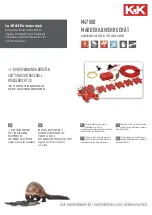
ML7984B
OPERATION AND CHECKOUT
Operation and checkout
Operation:
The recommended valve actuator power source is a class 2,
24V transformer or 28Vdc across terminals T5 &T6 (See
Fig.7). The internal circuitry provides dc power for the
electronic sensing and drive motor circuits. The sensing
circuits respond to the signal across the input terminals
based on the configuration DIP switches setting.
At the end of the valve stroke, the actuator continues to
drive and gradually develops the necessary force for
positive valve close-off.
automatically when the
predetermined current & for
The
motor
ce level
actuator
current
.
motor
reaches
stops
the
PWM mode:
The ML7984B is controlled by an intermittent voltage pulse
whose width varies in proportion to the desired actuator
position. This called pulse width modulation (PWM). The
PWM signal has two parts: a fixed pulse of a set width to
indicate a signal presence (e.g. 0.1 s) and a varible width
portion incremented in proportional to the signal percentage.
There are 255 increments available (e.g. 0.01 s). Thus, the
pulse width will be the minimum width plus the number of
increments times the incremental value (e.g. stroke mid
position is: 0.1s +128 x 0.01s = 1.38 s). The ML7984B
supports 5 different PMW timebased modes.
2-10 Vdc mode:
Control signal between signal input terminals is compared
to similar voltage across the actuator feedback
potentiometer. When these voltages are equal, the drive
motor and drive shaft are stationary.
As long as the value of controlled medium remains at the
controller setpoint, the circuit is in balance, and the actuator
does not run. When the value of the controlled medium
changes, the controller output voltage is changed causing
reference voltages in the circuit to be out of balance. As the
actuator moves in the direction to correct the medium
change, the feedback potentiometer also moves to rebalance
the circuit, and stop the actuator.
GENERAL NOTE:
1. For correct valve operation, the ML7984 must be field
configured with the DIP switches which are located beside
the terminal block, see wiring diagram for details. Turn
power off before setting the DIP switches .
2. There is a short delay in actuator response upon every
signal change. It is to screen any unwanted incoming signals.
3. For proper operation, voltage on the T5 & T6 must not
be less than 22Vac or 24Vdc during running or force
generating stages.
!
CAUTION:
1. Disconnect power supply before beginning installation to
prevent electrical shock and equipment damage.
2. All wiring must comply with applicable local electrical
codes, ordinances and regulations.
3. Make certain that the voltage and frequency of the power
supply correspond to the rating of the device.
4. DO NOT electrically operate the ML7984 before
assembly to the valve because damage not apparent to the
installer may occur.
Checkout:
1. Make sure the valve stem is completely screwed into the
actuator drive shaft with no threads showing.
2. Make sure the valve stem is locked in place with the set
screw.
3. Make sure the Configuration DIP switches are set
correctly.
4. With 24Vac or 28Vdc power source connected to T5 &
T6, actuator operation can be verified by connecting
appropriate control signal (PWM or 2-10Vdc) from
controller to the signal input terminals (Fig. 7).
For direct acting: A modulating action can be obtained
simply by increasing the control signal width or level. The
actuator will travel from a fully closed position (Stem down)
to a fully open position ( Stem up ). For 2-10Vdc mode,
actuator defaults to closed position on signal failure.
For reverse acting: Decreasing controller signal width or
level will drive actuator from fully closed (Stem down) to a
fully open position (Stem up). For 2-10Vdc mode, actuator
defaults to open position on signal failure.
5. Operate the system (valve, actuator and controller) for
several cycles to ensure proper installation.
6. When checkout is completed, return the controller to the
desired setting.
NOTE: Device will ignore any input changes until it has
completed its repositioning relative to the initial signal input.
Home and Building Control
Honeywell
Limited/Limitée
Home and Building Control
Honeywell Inc.
Helping You Control Your World
155 Gordon Baker Road
1985 Douglas Drive North
North York, Ontario
Golden Valley, Minnesota 55422
Canada M2H 3N7
www.honeywell.com/building/components



